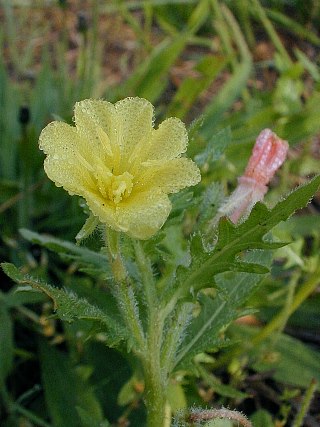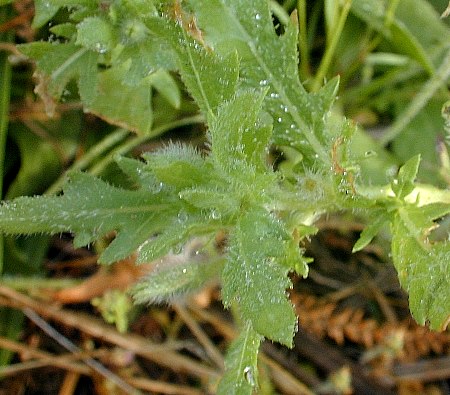Description:
This plant is an annual about ½–2' long that often
sprawls across the ground, or it is weakly ascending (particularly near
the tips of its branches). Small plants are usually unbranched, while
larger plants produce lateral stems occasionally. Each stem is terete,
light green, and more or less hairy. Along each stem, there are
alternate leaves up to 4" long and 1" across. The leaves
are
oblong-lanceolate to oblong-oblanceolate and pinnatifid; they are
hairy, although less so along their upper surfaces. The middle
to upper leaves are sessile, while the lower leaves have short
petioles. From the axils of the middle to upper leaves, there develops
individual flowers that are sessile. Each flower spans about 1" across
when it is fully open, consisting of 4 yellow petals, a narrowly
cylindrical calyx (about 2" long) with 4 narrowly triangular
lobe-segments at its apex, a narrowly cylindrical ovary/fruit (about
1–1½" long), 8 stamens, and a central united style with cross-shaped
stigmata. The flowers bloom at night and become closed during the
morning. Even though it appears that each flower has a stalk-like
pedicel about 3" long, this is actually the narrowly cylindrical calyx
and ovary/fruit of the flower. The lobe-segments of the calyx hang
downward. The blooming period occurs from late spring to mid-summer and
lasts about 1½–2 months. Only a few flowers are in bloom at the same
time. After pollination of a flower, the entire calyx becomes pale
salmon pink and falls off the fruit. The cylindrical fruit (or
developing seed capsule) is straight to slightly curved and ascends
upward; it is terete, slightly 4-ribbed, and more or less pubescent
along its length. This plant reproduces by reseeding itself; the
surfaces of the small seeds are pitted.
and 1" across. The leaves
are
oblong-lanceolate to oblong-oblanceolate and pinnatifid; they are
hairy, although less so along their upper surfaces. The middle
to upper leaves are sessile, while the lower leaves have short
petioles. From the axils of the middle to upper leaves, there develops
individual flowers that are sessile. Each flower spans about 1" across
when it is fully open, consisting of 4 yellow petals, a narrowly
cylindrical calyx (about 2" long) with 4 narrowly triangular
lobe-segments at its apex, a narrowly cylindrical ovary/fruit (about
1–1½" long), 8 stamens, and a central united style with cross-shaped
stigmata. The flowers bloom at night and become closed during the
morning. Even though it appears that each flower has a stalk-like
pedicel about 3" long, this is actually the narrowly cylindrical calyx
and ovary/fruit of the flower. The lobe-segments of the calyx hang
downward. The blooming period occurs from late spring to mid-summer and
lasts about 1½–2 months. Only a few flowers are in bloom at the same
time. After pollination of a flower, the entire calyx becomes pale
salmon pink and falls off the fruit. The cylindrical fruit (or
developing seed capsule) is straight to slightly curved and ascends
upward; it is terete, slightly 4-ribbed, and more or less pubescent
along its length. This plant reproduces by reseeding itself; the
surfaces of the small seeds are pitted.
Cultivation:
The preference is full sunlight, mesic to dry conditions, and sandy
soil where the ground vegetation is low and sparse. Most growth and
development occurs during the cool weather of spring.
Range & Habitat:
Ragged Evening Primrose is occasional throughout Illinois (see Distribution
Map), where it is native. Habitats include sand prairies,
hill prairies, sandy
fields and meadows, areas along railroads, roadsides, and waste areas.
Usually this wildflower is found in disturbed sandy habitats, although
it is occasionally found in barren gravelly areas. It is somewhat weedy.
Faunal Associations:
The flowers are pollinated by Sphinx moths and, to a lesser extent, by
bumblebees, honeybees, and other long-tongued bees. Small bees and
Syrphid flies may also visit the flowers, where they collect or feed on
the pollen, but these latter insects are less effective at
cross-pollination. Insects that feed on Ragged Evening Primrose and
other Oenothera spp. include several aphids, flea
beetles, weevils, moths, mealybugs, and other insects (see the Insect
Table for a listing of these species). The Mourning Dove has
been observed eating the seeds, while the Cottontail Rabbit and
White-Tailed Deer often browse on the foliage.

Photographic
Location:
A sandy meadow at the Heron Boardwalk in Vermilion County, Illinois.
Because the photograph was taken during the early morning, the flower
and foliage were still covered with dew; the flower is already
beginning to close.
Comments:
Because the flowers usually bloom at night, Ragged Evening Primrose is
a fairly low and inconspicuous plant. These flowers are very similar in
appearance to those of Oenothera biennis (Common
Evening Primrose) and other species in this genus. It is primarily the
pinnatifid shape of the leaves that sets Ragged Evening Primrose apart;
they have conspicuous lateral lobes. The leaf-margins of other Oenothera
spp. in Illinois are usually less wavy. Another common name
of Oenothera laciniata is Cutleaf Evening Primrose.